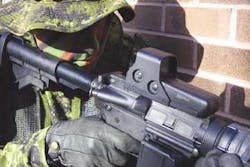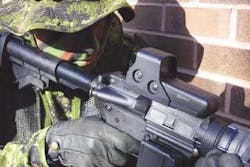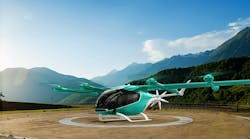EoTech holographic weapons sight deployed in Iraq
By John McHale
ANN ARBOR, Mich. — U.S. soldiers deployed in Iraq and Afghanistan are improving their ability to fight with a new holographic weapon sight from EoTech Inc. in Ann Arbor, Mich.
Soldiers with the 82 Airborne are using the EoTech Holographic Weapon Sight (HWS) 550 on their M-16 and M-4 rifles to improve their fighting capability in close quarters, says John Bailey, technical sales support at EoTech.
The optical weapon sight is fast, accurate, and offers substantial peripheral vision, EoTech officials say. The durable sight leaves no muzzle side operator signature, company officials claim. The technology is deployed with elite military special forces and SWAT teams worldwide, Bailey says.
Today's F-14 Tomcat jet fighters use holographic head-up display (HUD) technology to meet the requirement for super-fast, accurate target acquisition, yet this is the first application of holographic technology to small arms, Bailey claims.
EoTech officials demonstrated the sight to Military & Aerospace Electronics at the Association of the U.S. Army show this fall. During the demonstration two U.S. Army Rangers approached and tried it out, and when asked what is the biggest benefit of the HWS, one replied, "in close quarters, we would be able to get the shots off quickly and with more accuracy."
"As for the sights, well ... the best way to put it is ... they are like cheating," says a U.S. military special operations operator in Afghanistan. "Really, those things are the best tools that I have. It is so fast and easy to acquire that it's idiot proof. You don't loose the reticle in the bright light and the dot is super easy to acquire."
The unique qualities of EoTech's device revolve around its HUD; all the information necessary to reconstruct the reticle image is recorded everywhere in the HUD window, Bailey says. Shooters use the reticle — or the red circle — to aim when looking through the sight. A reticle is grid or pattern placed in the eyepiece of an optical instrument to establish scale or position.
If mud, snow, or water obstructs the window, the HWS remains operational and maintains point of aim/impact. Even in such extreme cases where the laminated window is shattered, the HWS functions as long as the operator can see through any portion of the window — the entire reticle pattern is visible on target.
Its range is solid at 200 meters and has been demonstrated at 300 meters, Bailey says. U.S. Marines qualify their marksmen at distances as far away from their targets as 500 meters, but EoTech is sticking to 200 meters as the standard range, he adds.
Holography can create virtually any image as a reticle pattern, in either two or three dimensions. Given sufficient volume, the HWS's reticle patterns can support a host of applications in small arms and medium-sized weapons, as well as individual launching platforms.
Reticle designs can incorporate several trajectory points of aim/points of impact, range-assisted scales, and antitorque or cant visual indicators. Reticles also can fabricate optical elements and ranging nomenclature in a noninterfering optical domain of the window to assist in target ranging and even dual-use images for M-16/203 weapons.
The HWS, which has two laser diodes that project the reticle image onto the glass, is waterproof, fogproof, shockproof, and withstands extreme temperature variations. It can withstand a 10-foot drop with no degradation to the weapon optic, company officials say.
Technicians test every HWS extensively in a recoil simulator that generates 3,500 Gs of acceleration in less than
0.5 milliseconds — the recoil of a 0.454 Casull revolver — as well as various environmental chambers, EoTech officials say.
The HUD has three-layers of 3/16- inch-thick shatterproof laminate glass, as well as a roll bar ruggedized hood.
The HWS has 30 brightness settings — 10 for night and 20 for daytime — which enables operators to see the reticles easily against white targets in full sunlight — even in desert or tundra environments, EoTech officials say.
With the HWS, there is no reticle "washout." Operators can adjust the device for moonlight or even dimmer conditions against dark targets without "overwhelming" the target scene.
For extreme low-light conditions, engaging the HWS's night vision mode enables the user to view the reticle pattern in tandem with advanced night-vision systems available today, company officials say.
An on-board microprocessor provides automatic battery check indicator, up/down brightness scrolling, and programmable auto shut down features. All electronics are in a shock-absorbing resin compound.
The HWS is a passive system, emits no muzzle side signature, and undetectable against enemy night-vision surveillance systems, EoTech officials say. This gives operators a stealthy means for nighttime weapon aiming, company officials say.
The M550 has 10 distinct night-vision settings; typically three to four brightness settings are not enough to support a host of constantly changing conditions including manufacturing variances in the sensitivities of the image intensifier tubes, varying ambient light environments, and varying light gathering sensitivities of the human eye across users.
The typical configuration is a monocular night-vision system with the HWS mounted in tandem on the weapon's receiver. The HWS has already been adapted to medium-sized-caliber machine guns, shoulder-fired weapons, and grenade launchers.
The HWS 550 uses AA batteries, which extends the battery life to more than 500 hours of continuous use at nominal level 12 brightness setting and is appropriate for artic or cold-weather operation. For more information on the HWS 550 contact the company at 734-741-8868 or online at www.eotech-inc.com.
Kollsman EVS installed on large FedEx Express cargo jets
By John McHale
MERRIMACK, N.H. — Engineers at Kollsman Inc. have designed an Enhanced Vision System (EVS) for large Federal Express Corp. (FedEx Express) cargo jets.
The Kollsman All Weather Window EVS will be standard equipment on the FedEx Express Boeing MD-10 and MD-11 and Airbus A300 and A310 aircraft fleet, Kollsman officials say.
Kollsman's All Weather Window presents an infrared sensor image onto a raster video-capable head-up display (HUD) and head-down display (HDD) to give the pilot a clear outside view in darkness, smoke, or bad weather. It uses proprietary video processing software algorithms to display its IR image.
The Kollsman EVS can help commercial, business, and military aircraft execute precision approaches and land safely in reduced-visibility conditions, Kollsman officials say. The All Weather Window also provides improved situational awareness during ground operations.
The EVS is scheduled for U.S. Federal Aviation Administration (FAA) certification by the end of 2006; installations begin in 2007 with HUD installations.
"EVS will improve schedule reliability by reducing weather-related delays, improve takeoff and landing minimums, and as a taxi aid in reducing the risk of runway incursions," says Don Barber, senior vice president of Air Operations, FedEx Express.
The All Weather Window consists of a 1-to-5-micron forward-looking infrared (FLIR) sensor; an electronics-processing box; and an IR window installed in the aircraft radome, Kollsman officials say.
The Kollsman EVS was first certified in September 2001 on the Gulfstream G-V business jet in partnership with Gulfstream Aerospace. Today Kollsman's EVS is available as optional equipment on the large-cabin, ultra-long-range Gulfstream G500 and G-V, the large-cabin, long-range Gulfstream G400 and G-IVSP business jets and the large-cabin, mid-range Gulfstream G300 business jets.
In addition the Kollsman EVS is standard equipment on the new large-cabin, ultra-long-range G550 as well as the newly announced long-range G450 business jets.
For more information on the EVS and Kollsman contact the company by phone at 603-886-2271 or online at www.kollsman.com.
Rockwell Collins to provide head-up displays for C-130J aircraft
Systems integrators at the Lockheed Martin Aeronautics Co. in Marietta, Ga., are contracting with Rockwell Collins in Cedar Rapids, Iowa, to provide head-up guidance systems for the C-130J multi-engine turboprop aircraft. Rockwell Collins will provide its Flight Dynamics HGS-3000 head-up guidance system for 60 C-130J aircraft for the U.S. Air Force and Marine Corps. The system's holographic combine enables the pilot to view important flight information at optical infinity. Aircraft flight path and acceleration, from the system's inertial reference system, appear as overlays on the outside real-world view in a true one-for-one relationship for enhanced situational awareness, energy management, approach stability, and touchdown precision, Rockwell Collins officials say.
NASA chooses FIS for custom optical patch cords for space
Systems designers at the National Aeronautics and Space Administration (NASA) are looking to Fiber Instrument Sales Inc. (FIS) of Oriskany, N.Y., for customized patch cords and test boxes for the space program, FIS officials say. FIS officials maintain a laboratory for custom work for virtually any application, company officials say. For more information contact FIS by phone at 315-736-3306, or online at www.fiberinstrumentsales.com.
Navy turns to Kollmorgen for shipboard optical sight systems
Experts at the U.S. Naval Sea Systems Command in Arlington, Va., are awarding a $6.9 million contract to Kollmorgen Electro Optical of Northampton, Mass., for five MK46 Mod 1 optical sight systems. Four of the systems will go aboard Arleigh Burke-class destroyers, and one will go to Japan under the Foreign Military Sales program. The MK46 optical sight, which is for the cruiser USS Yorktown, as well as for the Burke-class destroyers, is a two-axis gyro-stabilized sensor with color daylight imaging sensor, 3-to-5-micron thermal-imaging sensor, eye-safe laser rangefinder, and automatic video tracker. The sight is part of the MK34 Gun Weapon System, and enables the ship's primary gun to use radar or optoelectronic target tracking. For more information contact Kollmorgen Electro Optical by phone at 413-586-2330, by fax at 413-586-1324, by e-mail at [email protected], by post at 347 King St., Northampton, MA 01060, or online at www.eo.kollmorgen.com.
Intevac to prototype advanced single-photon sensor
Intevac Inc. of Santa Clara, Calif., won a $684,500 contract from Los Alamos National Laboratory in Albuquerque, N.M., to develop a prototype advanced single-photon sensor. The new sensor offers 3-D imaging to Intevac's LIVAR long-range target-identification system that enhances LIVAR for automated target-identification systems by giving it the capability to image the shape of a target, says Verle Aebi, president of Intevac's photonics technology division. Intevac will develop a prototype sensor to generate three-dimensional images. The new sensor, under development for the U.S. Department of Energy by Sandia National Laboratories and Los Alamos National Laboratory, will combine the LIVAR photocathode with a CMOS chip from Rockwell Scientific Co. For more information contact Intevac by phone at 408-986-9888, by fax at 408-727-5739, by post at 3560 Bassett St., Santa Clara, CA 95054, or online at www.intevac.com.




